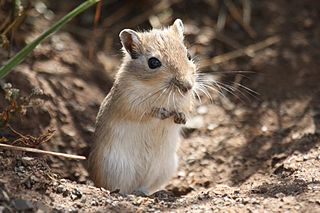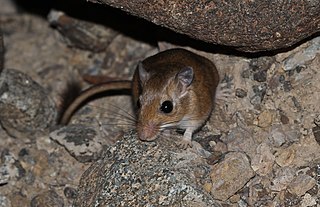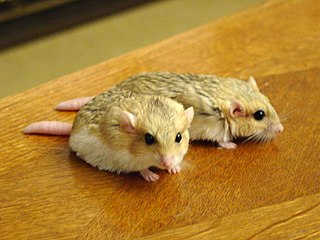
The Mongolian gerbil or Mongolian jird is a rodent belonging to the subfamily Gerbillinae. Their body size is typically 110–135 mm, with a 95–120 mm tail, and body weight 60–130 g, with adult males larger than females. The animal is used in science and research or kept as a small house pet. Their use in science dates back to the latter half of the 19th century, but they only started to be kept as pets in the English-speaking world after 1954, when they were brought to the United States. However, their use in scientific research has fallen out of favor.

Gerbillinae is one of the subfamilies of the rodent family Muridae and includes the gerbils, jirds, and sand rats. Once known as desert rats, the subfamily includes about 110 species of African, Indian, and Asian rodents, including sand rats and jirds, all of which are adapted to arid habitats. Most are primarily active during the day, making them diurnal, and almost all are omnivorous.

Wagner's gerbil is a gerbil that is native mainly to the Nile Delta, Israel, the Sinai, Syria, Iraq and the Arabian Peninsula. It also referred to as the rough-tailed dipodil or Wadi Hof gerbil. They are solo, burrowing mammals that are nocturnally active.
Botta's gerbil is a species of gerbil endemic to Sudan and possibly northern Kenya. According to the International Union for Conservation of Nature, it was listed as Least Concern in 1996 until it was listed as Data Deficient in 2004. According to a 2013 book, it is known from a few specimens taken from four or five localities in a small area between the rivers White Nile and Blue Nile; its habitat is fields of vegetables and cereals. Aside from this information, nothing else is known about the species including its population and threats.

Cheesman's gerbil is a small rodent in the subfamily Gerbillinae of the family Muridae. It is distributed mainly in Arabian Peninsula to southwestern Iran. It has orange-brown fur, white underparts, large eyes and a very long tail.

Gerbillus is a genus that contains most common and the most diverse gerbils. In 2010, after morphological and molecular studies Dipodillus was ranged as a subgenus of Gerbillus, however some taxonomic authorities continue to separate them.

The fat-tailed gerbil, also called the duprasi gerbil or doop, is a rodent belonging to the subfamily Gerbillinae. It is only species in the genus Pachyuromys. They are frequently kept as pets.
The pouched gerbil is a species of rodent in the family Muridae. It is the only species in the genus Desmodilliscus and the subtribe Desmodilliscina.

The Cape short-eared gerbil is a species of rodent in the family Muridae. It is the only species in the genus Desmodillus. It is found in Angola, Botswana, Namibia, and South Africa. Its natural habitats are hot deserts and temperate desert.

The North African gerbil is a species of rodent in the family Muridae. It is found in North Africa where its natural habitats are arable land and rocky areas of the Maghreb, and hot Saharan deserts.

Gerbillurus is a genus of rodent in the family Muridae. It contains the following species:
The Namib brush-tailed gerbil or Setzer's hairy-footed gerbil is a species of rodent endemic to Angola and Namibia. Its natural habitats are sandy and gravelly plains. It stays in its burrow by day, emerging at night to feed on arthropods, vegetable matter, and seeds.
The dune hairy-footed gerbil, or the Namib dune gerbil is a species of rodent found only in Namibia. Its natural habitat is temperate desert where it lives in loose sand among sand dunes, feeding opportunistically on arthropods, seeds and green vegetation.
Mackilligin's gerbil also known as Mackilligin's dipodil, is a species of rodent in the family Muridae. It occurs in the southeastern deserts of Egypt and Sudan, around the area of the Halaib Triangle. It has been grouped with Dipodillus nanus, but is now considered specifically distinct.

The tamarisk jird or tamarisk gerbil is a species of rodent in the family Muridae. It is found in China, Mongolia, Kazakhstan, Kyrgyzstan, Russia, Turkmenistan, and Uzbekistan. It prefers habitats with grass or shrub cover.
Boehm's gerbil is a species of rodent found in Angola, Burundi, Democratic Republic of the Congo, Kenya, Malawi, Mozambique, Rwanda, Tanzania, Uganda, and Zambia. Its natural habitats are dry savanna, moist savanna, and arable land. This is a common species with a wide distribution which faces no obvious threats, so in 2004 the International Union for Conservation of Nature rated its conservation status as being of "least concern".

The Indian gerbil also known as antelope rat, is a species of rodent in the family Muridae.

Gerbilliscus is a genus of rodent in the subfamily Gerbillinae (gerbils) of the family Muridae. It contains the following species, all native to Africa:











